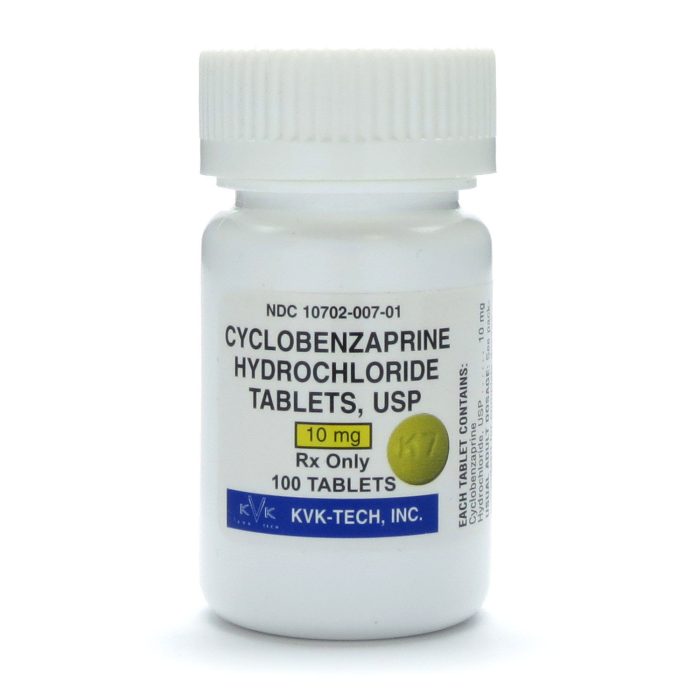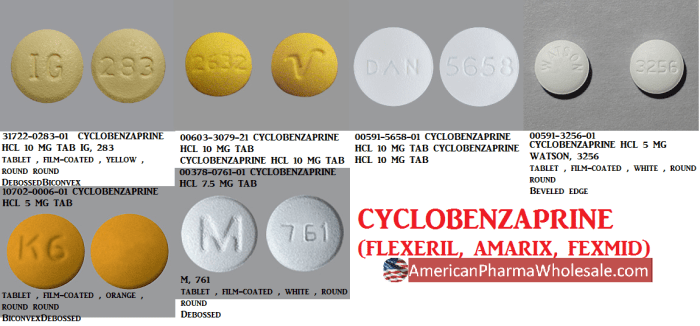Cyclobenzaprine 10 mg, a commonly prescribed muscle relaxant, plays a significant role in managing muscle spasms and associated pain. This medication works by affecting the central nervous system, reducing muscle stiffness and discomfort. It is often used to treat conditions like acute back pain, neck pain, and muscle strains, providing relief from the debilitating symptoms of muscle spasms.
Cyclobenzaprine is available in various forms, including tablets, capsules, and extended-release formulations, allowing for flexible dosing options. The effectiveness of cyclobenzaprine in relieving muscle spasms has been well-established through numerous clinical studies, making it a valuable tool in the management of musculoskeletal pain.
Alternatives and Comparative Effectiveness

Cyclobenzaprine is a muscle relaxant that is commonly prescribed to treat muscle spasms. However, it is important to understand that cyclobenzaprine is not the only option available for managing muscle spasms. There are several alternative medications and treatment approaches that can be considered, each with its own advantages and disadvantages. This section will delve into these alternatives and compare their effectiveness, side effect profiles, and other relevant characteristics.
Alternative Medications
Muscle spasms can result from various underlying conditions, and treatment often involves addressing the root cause. However, for symptomatic relief, several medications besides cyclobenzaprine are available. These include:
- Other Muscle Relaxants: Medications like tizanidine (Zanaflex) and baclofen (Lioresal) are also commonly prescribed for muscle spasms. They work by relaxing the muscles and reducing stiffness, but they can also cause drowsiness and dizziness.
- Anti-Inflammatory Medications: Nonsteroidal anti-inflammatory drugs (NSAIDs) like ibuprofen and naproxen can help reduce inflammation and pain associated with muscle spasms. However, they can cause gastrointestinal side effects, such as stomach upset and ulcers.
- Opioid Analgesics: In severe cases of muscle spasms, opioids like tramadol or oxycodone may be used to manage pain. However, opioids have a high risk of addiction and should be used with caution.
- Botulinum Toxin Injections: Injections of botulinum toxin (Botox) can be effective in reducing muscle spasms, especially in cases of focal muscle spasms. However, this treatment is typically reserved for severe cases or when other therapies have failed.
Comparative Effectiveness
The effectiveness of different treatments for muscle spasms varies depending on the underlying cause and the individual patient. In general, cyclobenzaprine is considered effective for short-term relief of muscle spasms, but it may not be suitable for long-term use.
- Cyclobenzaprine: Cyclobenzaprine is effective for short-term relief of muscle spasms, but it can cause drowsiness and dizziness. It is not recommended for long-term use.
- Other Muscle Relaxants: Tizanidine and baclofen can be effective for both short-term and long-term management of muscle spasms. However, they can also cause drowsiness, dizziness, and other side effects.
- Anti-Inflammatory Medications: NSAIDs can help reduce inflammation and pain associated with muscle spasms, but they can cause gastrointestinal side effects.
- Opioid Analgesics: Opioids can be effective for pain relief, but they have a high risk of addiction and should be used with caution.
- Botulinum Toxin Injections: Botulinum toxin injections can be effective for focal muscle spasms, but they are typically reserved for severe cases or when other therapies have failed.
Rationale for Choosing Cyclobenzaprine
The choice of treatment for muscle spasms depends on several factors, including the severity of the spasms, the underlying cause, and the patient’s medical history. Cyclobenzaprine may be a suitable option for patients with mild to moderate muscle spasms who are not at risk for addiction or other complications.
- Mild to Moderate Muscle Spasms: Cyclobenzaprine is often a suitable option for patients with mild to moderate muscle spasms.
- Short-Term Use: Cyclobenzaprine is generally recommended for short-term use, typically for a few weeks.
- No Risk Factors: Cyclobenzaprine may be a good choice for patients who are not at risk for addiction, drug interactions, or other complications.
Research and Development: Cyclobenzaprine 10 Mg

Cyclobenzaprine, a muscle relaxant, has been used for decades to alleviate muscle spasms and associated pain. While its efficacy and safety profile are well-established, ongoing research continues to explore new applications and refine its use.
Ongoing Research
Ongoing research focuses on understanding the mechanisms of action of cyclobenzaprine and its impact on muscle spasms and related conditions. Researchers are exploring its potential for treating various conditions, including:
- Fibromyalgia: Studies are investigating cyclobenzaprine’s effectiveness in managing fibromyalgia symptoms, including muscle pain and fatigue.
- Chronic Pain: Research is examining its potential role in managing chronic pain conditions, such as chronic low back pain and neuropathic pain.
- Spasticity: Studies are exploring cyclobenzaprine’s ability to reduce spasticity, a condition characterized by muscle stiffness and involuntary muscle contractions, often associated with neurological disorders like multiple sclerosis.
Regulatory Information and Availability

Cyclobenzaprine is a prescription medication, meaning it is only available with a doctor’s prescription. Its availability and accessibility can vary depending on the country and healthcare setting.
Regulatory Status, Cyclobenzaprine 10 mg
The regulatory status of cyclobenzaprine can vary depending on the country. Here’s an overview:
* United States: The Food and Drug Administration (FDA) has approved cyclobenzaprine for the short-term relief of muscle spasms. It is classified as a Schedule IV controlled substance in the US, indicating a low potential for abuse and dependence.
* Canada: Health Canada has approved cyclobenzaprine for the short-term relief of muscle spasms. It is classified as a Schedule IV controlled substance in Canada.
* European Union: Cyclobenzaprine is not approved for use in the European Union.
* Other Countries: The regulatory status of cyclobenzaprine varies in other countries. It is important to consult with local health authorities or a healthcare professional for specific information on the availability and regulatory status in a particular country.
Availability and Accessibility
Cyclobenzaprine is typically available in pharmacies, both in physical locations and online. However, access to the medication may be restricted in certain healthcare settings.
* Hospitals: Cyclobenzaprine is typically available in hospital pharmacies for patients who need it.
* Clinics: Clinics may or may not stock cyclobenzaprine, depending on the specific clinic and its patient population.
* Long-Term Care Facilities: Long-term care facilities may have restrictions on the use of cyclobenzaprine due to its potential side effects and interactions with other medications.
Prescription and Dispensing Guidelines
Specific guidelines and regulations related to the prescription and dispensing of cyclobenzaprine can vary depending on the country and healthcare system.
* Prescription Requirements: In most countries, cyclobenzaprine is only available with a valid prescription from a licensed healthcare professional.
* Dispensing Restrictions: Pharmacists may have restrictions on the quantity of cyclobenzaprine they can dispense at a time. They may also need to monitor patients for signs of abuse or dependence.
* Patient Counseling: Pharmacists are typically required to provide patients with counseling on the proper use of cyclobenzaprine, including potential side effects and interactions.
Understanding the nuances of cyclobenzaprine 10 mg, including its mechanism of action, potential side effects, and interactions, is crucial for patients and healthcare providers. While this medication can provide significant relief for muscle spasms, it’s essential to use it responsibly and under the guidance of a healthcare professional. By adhering to prescribed dosages and monitoring for any adverse effects, individuals can maximize the benefits of cyclobenzaprine while minimizing potential risks.
Cyclobenzaprine 10 mg is a muscle relaxant commonly prescribed to alleviate muscle spasms and pain. It’s important to note that while cyclobenzaprine primarily targets muscle issues, it can sometimes interact with other medications, like carbidopa levodopa , which is used to treat Parkinson’s disease. Therefore, it’s crucial to consult your doctor before taking cyclobenzaprine, especially if you’re already on other medications, to ensure safe and effective treatment.